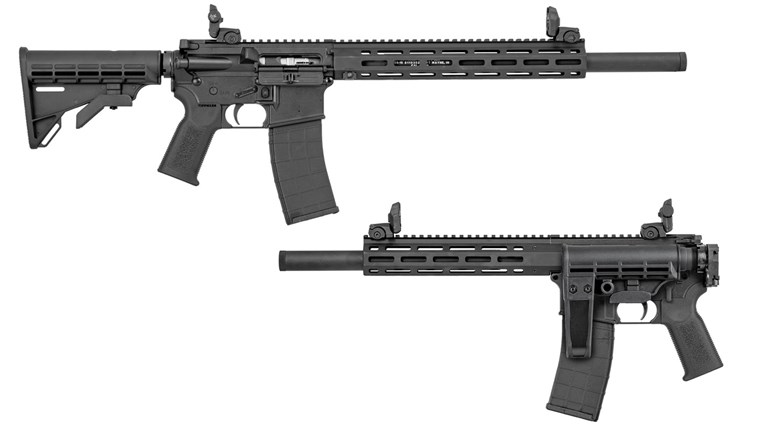

Excessive stress is hard on everyone and everything. Precision optics are no exception and often suffer (silently) from misaligned scope rings. In spite of their seemingly rigid designs, riflescopes flex and bend, sometimes permanently. The more a scope's tube is distorted, the greater the stresses placed on its complex internal lens arrays and mechanisms. Even heavy-gauge, steel-bodied optics flex when enough pressure is applied. Unfortunately many scope rings are not all that well aligned, though it is virtually impossible to spot with the naked eye. The same goes for rails and mounting bases, often made of aluminum and not necessarily manufactured with maximum precision in mind. Fortunately we can remedy minor cases of either problem thanks to scope ring lapping kits from Sinclair International and Wheeler Engineering. Aligning scope rings aids accuracy, helps the optic work properly and can prolong its service life.
These kits are not exactly cheap, unless you plan to mount a bunch of scopes or continually swap rings and mounts. Fortunately many gunsmiths offer this service for a nominal fee. The actual checking and lapping processes are simple. I use the Wheeler kit, which consists of a pair each of 1 inch and 30 mm alignment rods (turned to a point on one end) as well as a pair of lapping rods in each size and a threaded handle. As of this moment, I have not found a commercial 34 mm lapping set. I turned a set of alignment and lapping rods on my lathe so if you need a set, check with a local machinist. A picture of an existing lapping kit and the desired measurements should be enough to get you a custom set.
Stabilizing the gun in a cradle or rest will help you during the lapping process. When lapping separate scope rings, I set them as far apart on the mounting rail as possible in order to provide the maximum lapping rod movement (covered later). It is best to lap a set of rings on the receiver they will be used on because of the potential for receiver rail imperfections.
The first step is to select the correct size alignment rods and insert them with the points facing each other so that they are nearly touching. Then slowly tighten the ring screws so that the ring halves secure the rods in place. The rings should be fully and evenly tightened, just as when a scope is mounted. Once fully tightened, check the alignment rod points from the side and from above. If you are lucky, perfect alignment will be indicated by the points being directly or very nearly opposed. It is not uncommon to have a small amount of offset in the tips which is exactly what the lapping rods are designed to remedy.
To begin lapping, remove the alignment rods and insert the correctly-sized lapping bar and handle. A lapping compound will be needed at this point. I use 600 grit, applying it on either side of the rings once the rod is inserted. The ring halves should be snug but still allow the lapping rod to move laterally and rotationally. Once you are set, the lapping rod handle will allow you to slide the rod back and forth while simultaneously rotating in a sort of figure-eight pattern. It will feel very gritty and tight at first but once you get going you can pick up a rhythm. I time my lapping at about five minutes before stopping to re-check alignment. After the first minute, tighten the rings a little further. The tighter the rings (while still allowing lap rod movement) the more effective the effort. After lapping, remove the rod and ring halves, clean all the lapping compound out of the rings—including any that has worked its way into the screw holes—then reinsert the alignment rods and tighten everything back down. Check the alignment rod points to see if they meet. If not, repeat the process until they do. You can alter the amount of lapping compound used, the grit size and the lapping time based on how little or much progress you see.
I would be lying if I said I lap all rings and mounts that I set up. If the rifle and optic are intended for close to mid-range work and not designed to drive nails in by their heads, I do not lap. I do lap whenever precision shooting is part of the equation. I also check alignment whenever I am troubleshooting accuracy issues. I have found that optics mounted in misaligned rings often do not track properly when adjusted and zero retention can also be problematic.
After lapping, I mark the insides of the rings so that the halves stay paired up and in the case of separate rings, I mark the fore and aft ends too. That way everything stays exactly as it was when aligned. If the alignment rod tips are far out of whack when you first check them—say 1/8 inch or more—there is a greater problem in play. Check your rings to ensure they are both correctly installed on the receiver or base. Also, check them on another receiver or rail. Sometimes just swapping ring halves or switching places on the rail will help enough to make lapping feasible. Once your alignment rod points match up nicely you will have the confidence of knowing your riflescope is perfectly placed in its mount, which also removes at least one reason for missed shots from your list of excuses.





































